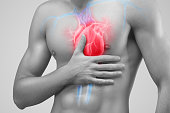Heart Disease

Heart Attack or Cardiac Arrest?
Statistics shows that several thousands of people die daily of heart disease globally. One need to know about the difference between heart attack and cardiac arrest, the leading causes of heart-related deaths. Perhaps it’s a good idea for all of us to educate ourselves of these diseases. When the heart is in a really bad shape, the outcome of neither a heart attack nor a cardiac arrest is in our control, so it might be a good idea to do something about our heart before it gets really bad and destroys us.
Heart Attack:
Heart attack is a problem of difficulty in pumping blood in and through the heart as a result of weak heart muscles or blocked arteries due to high cholesterol or plaque, a condition also known as ‘atherosclerosis‘. A cardiac arrest, on the other hand, is a damage or irregularity of heart’s rhythm (too fast, too slow or just no rhythm at all), also called ‘arrhythmia’ or ‘atrial fibrillation’.
This could happen as a result of several things: Long QT Syndrome (LQTS), Brugada Syndrome, Catecholaminergic Polymorphic Ventricular Tachycardia (CVPT), Arrhythmogenic Right Ventricular Cardiomyopathy (ARVC) or Hypertrophic Cardiomyopathy.
There are, however, some warning signs, and it would be good to heed to them. Heart attacks occur due to blocked arteries. The plaque inside the arteries builds up gradually, over the years, causing angina pain or heart attack. If we let our arteries get blocked to the extent of getting a heart attack or requiring a heart surgery, we can blame ourselves – because it is ultimately our fault.
There are several risk factors, some of which such as genetics may not be in our hand, but avoiding conditions that lead to atherosclerosis is in our hands. Unfortunately, heart attack is a silent killer, in the sense, there are usually no visible symptoms until the arteries are at least 75% blocked.
Taking precautions such as diet control, regular exercise, controlling stress, etc, can help us get on back a healthy heart. It is possible to eliminate blockages, by doing simple things such as eating well and doing moderate exercise, and say no to heart attacks.
Cardiac Arrest:
There are three key warning signs that need to be noted for cardiac arrest: dizzy spells or passing out during exercise, fainting as a result of a loud noise or being startled or family history of sudden deaths due to heart failure.
A simple electrocardiogram, an echocardiogram or a heart ultrasound can detect arrhythmia. Treatment options include antiarrhythmic drugs, anticoagulation therapy, electrical or chemical cardioversion, catheter ablation of the AV (atrioventricular) node, pulmonary vein antrum isolation (PVAI), etc.
There are risks involved in every procedure, so its best to check with the medical professionals to determine what works best for you. A person suffering from atrial fibrillation (AF) will know something is wrong, with his/her heart beats.
Normally young athletes who suffer from AF are more likely of cardiac arrest in the middle of their routine – because they perhaps stretched themselves despite being aware that their heart rhythm was not right. A fainting spell or dizziness cannot be missed, especially if the condition is known earlier.So prevention is better than cure.

Comments
Post a Comment